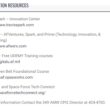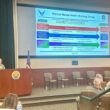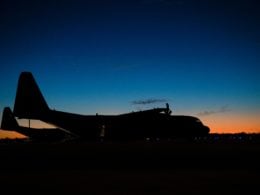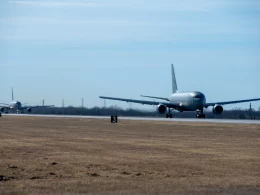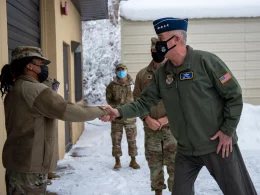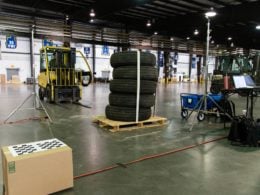HURLBURT FIELD, Fla. —
Royal Air Force, Royal Australian Air Force, U.S. Air Force, U.S. Air Force Reserve Command and U.S. Air National Guard warfighters recently graduated the U.S. Air Force’s premier operational-level command and control course designed to advance the operational-level planning expertise of experienced air component (Air Force forces & air operations center) planners, at Hurlburt Field, Florida, Apr. 4.
This was the first course where we were able to incorporate Australia and United Kingdom planners into the same course and it brought an awesome multi-national coalition mindset to this class; I look forward to more classes like this in the future.”
Lt. Col. Benjamin Lee, 705th Training Squadron commander
“Our continuous real-world updates to our dual-scenario course focuses on an Indo-Pacific pacing challenge, deterrence of Russian aggression and developing highly effective operational-level planners that can lead OPGs and APGs [operational planning groups and air planning groups],” said U.S. Space Force Capt. Joel Boxberger, Command and Control Warrior Advanced Course director for the 705th Training Squadron.
Twenty-one Total Force Airmen and two coalition warfighters attended the Command and Control Warrior Advanced Course 24-03, or C2WAC, to learn how to integrate both kinetic and non-kinetic capabilities available to the Combined/Joint Force Air Component Commander.
“This was the first course where we were able to incorporate Australia and United Kingdom planners into the same course and it brought an awesome multi-national coalition mindset to this class; I look forward to more classes like this in the future,” said U.S. Air Force Lt. Col. Benjamin Lee, 705th TRS commander.
C2WAC, taught by the 705th TRS, is an advanced, multi-domain, integration course that trains air component headquarters personnel how to plan and execute air component operations at the operational level to meet joint force commander requirements. The course uses the joint planning process for air and the joint air tasking cycle framework to steep students in the planning, integration, and execution responsibilities of the air component across the competition continuum at the operational level.
“The practical exercises were a great tool to allow us to get multiple repetitions applying the course material. The course had and needs to have an environment to where students can apply the planning process and fail at it. We will not be successful the first time around, but this course produced a safe space to fail, learn from the failure, and improve. Continuing to implement opportunities to plan and with realistic compressed timelines will strengthen the skillsets of future graduates of this course,” said U.S. Air Force Maj. Nick Davis, 4th Combat Training Squadron director of operations, Ramstein Air Force Base, Germany.
In order to offer Mission Ready Airmen and our coalition partners training focusing on a variety of capabilities needed for operational mission readiness during a war, the 705th TRS continuously develops the C2WAC curriculum.
“In a class brimming with talent and experience, I initially felt out of my depth. Yet, despite the steep learning curve, I am so proud of where I have come from, and I realized our diverse perspectives and backgrounds were the true treasure. I am truly thankful for this course, and I am so excited to apply what I have learned,” said U.S. Air Force Maj. Solange Douglass, 700th Air Support Squadron, Continuity Operations chief, Joint Base Langley-Eustis, Virginia.
C2WAC is taught at the integrated joint special technical operations level, targeting air component headquarters mid-level leaders (officers, noncommissioned officers and civilians), culminating with the awarding of the A-prefix to officer Air Force Specialty Codes and the M-prefix to enlisted AFSCs and designated as multi-domain warfare planners.
“The practical exercises were the most helpful to learn lesson concepts as I was able to match specifications to the scenario and war-game with my classmates on solutions. The time crunch was also an amplifying factor as it helped me to prioritize what was important to the scenario, solidifying the intent of the task, elaborating on the learning objectives, and fostering collaboration with a diverse team to achieve desired end states. Last but not least, the experience of the cadre as well as the class mentors helped frame problem sets that we missed and greatly assisted the digestion of the lessons, both academically and practically,” said U.S. Air Force Master Sgt. Wong Ly, 33d Cyberspace Operations Squadron, Operations flight chief, Lackland AFB, Texas.
“I really enjoyed the course. This entire process will set me up for success in my career because I am in APG/OPGs on a daily basis,” said U.S. Air National Guard Capt. Andrew Gray, 601st AOC strategy planner, Tyndall AFB, Florida.
C2WAC graduates are poised to lead operational planning teams and groups and trained on the effective integration across warfighting domains to provide the operational advantage to the commander of AFFOR, JFACC, and JFC.
“The U.S. Air Force identified the critical need for more operationally minded planners trained and equipped to synchronize effects across all domains, and that is the primary focus of C2WAC. The feedback that we are getting from the field is that C2WAC graduates are really making an impact in AOCs and headquarters world-wide…and I am confident that class 24-03 is ready to plan against the complexities of the next challenge,” said Lee.
The distinguished graduate for C2WAC 24-03 was awarded to U.S. Air Force Maj. Andrew Kearl.
“The instructional staff were absolutely phenomenal. The class mentors were also some of the best instructors I’ve ever had, and I could listen to them just lecture for days. Having Col. Hayde [505th CCW commander] talk to us on the last day was also a breath of fresh air. I think the people behind C2WAC are truly fantastic in their respective fields and at instructing, and I’d have them teach me rocket science and probably walk out with an understanding of the information,” said U.S. Air Force Capt. Alexander Stadlin, 18th Wing Staff Agency Wing Innovations director, Kadena Air Base, Japan.
The 705th TRS reports to the 505th Test and Training Group, which is assigned to the 505th Command and Control Wing; both are headquartered at Hurlburt Field, Florida.
C2WAC 24-03 Graduates by Service and Unit:
Royal Air Force:
11 Group, RAF High Wycombe
Royal Australian Air Force:
88 Squadron, Edinburgh
U.S. Air National Guard
101st Air Communications Squadron
183rd Airlift Squadron
193rd Cyberspace Operations Squadron
601st Air Operations Center
611th Air Operations Center
U.S. Air Force Reserve Command
701st Cyberspace Operations Squadron
U.S. Air Force
Headquarters U. S. Air Forces in Europe – Air Forces Africa
1st Combat Communications Squadron
4th Air Support Operations Group
4th Combat Training Squadron
14th Air Support Operations Squadron
18th Wing Staff Agency
33d Cyberspace Operations Squadron
49th Wing
86th Operations Support Squadron
613th Air Operations Center
616th Operations Center
618th Air Operations Center
700th Air Support Squadron
909th Air Rescue Squadron





